谷胱甘肽 S-转移酶(glutathione S-transferase,GST)试剂盒说明书
- 格式:doc
- 大小:55.50 KB
- 文档页数:2
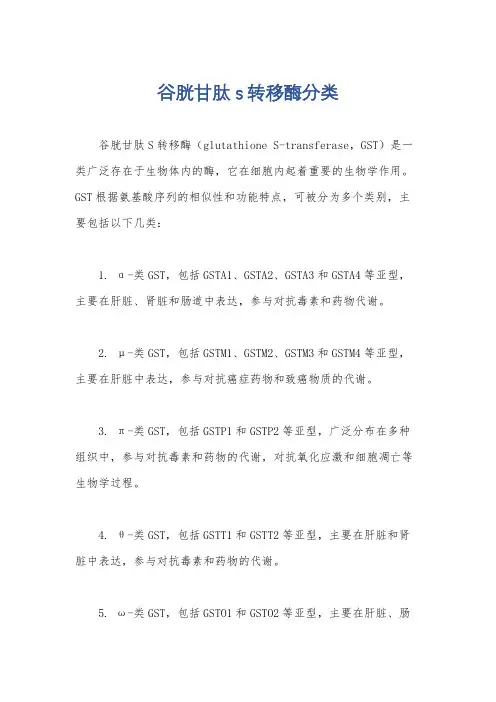
谷胱甘肽s转移酶分类
谷胱甘肽S转移酶(glutathione S-transferase,GST)是一类广泛存在于生物体内的酶,它在细胞内起着重要的生物学作用。
GST根据氨基酸序列的相似性和功能特点,可被分为多个类别,主要包括以下几类:
1. α-类GST,包括GSTA1、GSTA2、GSTA3和GSTA4等亚型,主要在肝脏、肾脏和肠道中表达,参与对抗毒素和药物代谢。
2. μ-类GST,包括GSTM1、GSTM2、GSTM3和GSTM4等亚型,主要在肝脏中表达,参与对抗癌症药物和致癌物质的代谢。
3. π-类GST,包括GSTP1和GSTP2等亚型,广泛分布在多种组织中,参与对抗毒素和药物的代谢,对抗氧化应激和细胞凋亡等生物学过程。
4. θ-类GST,包括GSTT1和GSTT2等亚型,主要在肝脏和肾脏中表达,参与对抗毒素和药物的代谢。
5. ω-类GST,包括GSTO1和GSTO2等亚型,主要在肝脏、肠
道和肾脏中表达,参与对抗氧化应激和神经退行性疾病的发生。
除了上述主要的GST类别外,还有一些其他类别的GST,它们在细胞内扮演着重要的角色,如参与对抗氧化应激、解毒和药物代谢等生物学过程。
总的来说,GST的分类是根据其氨基酸序列的相似性和功能特点进行的,不同类别的GST在细胞内具有不同的生物学功能和代谢途径。

小鼠还原型谷胱甘肽(GSH)快速检测试剂盒使用说明书本试剂盒仅供研究使用产品编号:CSB-E11897m检测范围:0.8 ng /ml -200ng /ml特异性:本试剂盒可同时检测天然或重组的GSH,且与其他相关蛋白基本无交叉反应。
有效期:6个月(2-8℃避光保存)预期应用:ELISA法定量测定小鼠血清,血浆及其它相关生物液体中GSH含量。
说明1.浓洗涤液低温保存会有盐析出,稀释时可在水浴中加温助溶。
2.刚开启的酶联板孔中可能会含有少许水样物质,此为正常现象,不会对实验结果造成任何影响。
实验原理采用竞争酶联免疫法法检测GSH含量。
首先用一株单抗体包被微孔板,制备成固相抗体,然后加入待测标本及辣根过氧化物酶标记的另一株单抗,使之形成包被抗体-GSH-酶标记抗体的复合物。
经显色后在酶标仪测定吸光值(OD 值),通过计算机或作图拟合浓度-吸光度曲线,反算出待测标本中GSH含量。
试剂盒组成及试剂配制1.酶联板(Assay plate ):一块(96孔)。
2.标准品(Standard):5瓶(冻干品)。
标准品为冻干品,使用前分别用0.5ml蒸馏水溶解,溶解后浓度分别为:3.酶结合物(HRP-conjugated antibody):1×6ml/瓶。
4.显色剂A(Substrate A):1×7ml/瓶。
5.显色剂B(Substrate B):1×7ml/瓶。
6.浓洗涤液(Wash Buffer):1×15ml/瓶,使用时每瓶用蒸馏水稀释20倍。
7.终止液(Stop Solution):1×7ml/瓶需要而未提供的试剂和器材1.标准规格酶标仪2.高速离心机3.电热恒温培养箱4.干净的试管和Eppendof管5.系列可调节移液器及吸头,一次检测样品较多时,最好用多通道移液器6. 蒸馏水,容量瓶等标本的采集及保存1.血清:全血标本请于室温放置2小时或4℃过夜后于1000 x g离心20分钟,取上清即可检测,或将标本放于-20℃或-80℃保存,但应避免反复冻融。
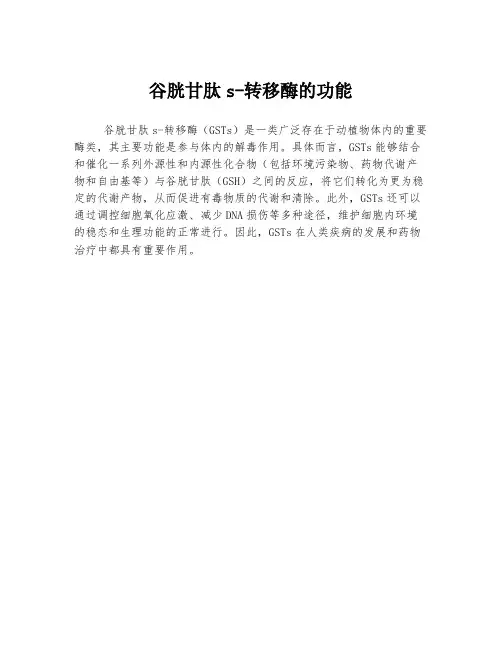
谷胱甘肽s-转移酶的功能
谷胱甘肽s-转移酶(GSTs)是一类广泛存在于动植物体内的重要酶类,其主要功能是参与体内的解毒作用。
具体而言,GSTs能够结合和催化一系列外源性和内源性化合物(包括环境污染物、药物代谢产物和自由基等)与谷胱甘肽(GSH)之间的反应,将它们转化为更为稳定的代谢产物,从而促进有毒物质的代谢和清除。
此外,GSTs还可以通过调控细胞氧化应激、减少DNA损伤等多种途径,维护细胞内环境的稳态和生理功能的正常进行。
因此,GSTs在人类疾病的发展和药物治疗中都具有重要作用。
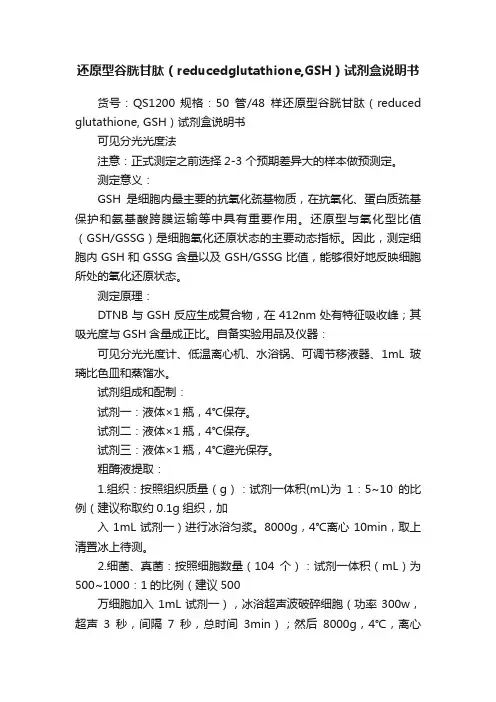
还原型谷胱甘肽(reducedglutathione,GSH)试剂盒说明书货号:QS1200 规格:50管/48样还原型谷胱甘肽(reduced glutathione, GSH)试剂盒说明书可见分光光度法注意:正式测定之前选择2-3 个预期差异大的样本做预测定。
测定意义:GSH是细胞内最主要的抗氧化巯基物质,在抗氧化、蛋白质巯基保护和氨基酸跨膜运输等中具有重要作用。
还原型与氧化型比值(GSH/GSSG)是细胞氧化还原状态的主要动态指标。
因此,测定细胞内GSH和GSSG含量以及GSH/GSSG比值,能够很好地反映细胞所处的氧化还原状态。
测定原理:DTNB与GSH反应生成复合物,在412nm处有特征吸收峰;其吸光度与GSH含量成正比。
自备实验用品及仪器:可见分光光度计、低温离心机、水浴锅、可调节移液器、1mL玻璃比色皿和蒸馏水。
试剂组成和配制:试剂一:液体×1瓶,4℃保存。
试剂二:液体×1瓶,4℃保存。
试剂三:液体×1瓶,4℃避光保存。
粗酶液提取:1.组织:按照组织质量(g):试剂一体积(mL)为1:5~10的比例(建议称取约0.1g组织,加入1mL试剂一)进行冰浴匀浆。
8000g,4℃离心10min,取上清置冰上待测。
2.细菌、真菌:按照细胞数量(104个):试剂一体积(mL)为500~1000:1的比例(建议500万细胞加入1mL试剂一),冰浴超声波破碎细胞(功率300w,超声3秒,间隔7秒,总时间3min);然后8000g,4℃,离心10min,取上清置于冰上待测。
3.血清等液体:直接测定。
GSH测定操作:1. 分光光度计预热30min,调节波长到412 nm,蒸馏水调零。
2. 试剂二置于25℃(一般物种)或者37℃(哺乳动物)水浴中保温30min。
3. 空白管:取1mL玻璃比色皿,依次加入100μL蒸馏水,700μL 试剂二,200μL试剂三,混匀静置2min后测定412 nm吸光度A1。
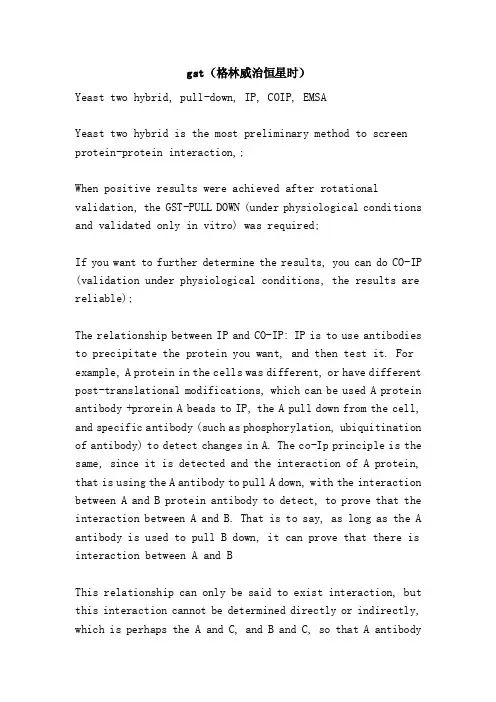
gst(格林威治恒星时)Yeast two hybrid, pull-down, IP, COIP, EMSAYeast two hybrid is the most preliminary method to screen protein-protein interaction,;When positive results were achieved after rotational validation, the GST-PULL DOWN (under physiological conditions and validated only in vitro) was required;If you want to further determine the results, you can do CO-IP (validation under physiological conditions, the results are reliable);The relationship between IP and CO-IP: IP is to use antibodies to precipitate the protein you want, and then test it. For example, A protein in the cells was different, or have different post-translational modifications, which can be used A protein antibody +prorein A beads to IP, the A pull down from the cell, and specific antibody (such as phosphorylation, ubiquitination of antibody) to detect changes in A. The co-Ip principle is the same, since it is detected and the interaction of A protein, that is using the A antibody to pull A down, with the interaction between A and B protein antibody to detect, to prove that the interaction between A and B. That is to say, as long as the A antibody is used to pull B down, it can prove that there is interaction between A and BThis relationship can only be said to exist interaction, but this interaction cannot be determined directly or indirectly, which is perhaps the A and C, and B and C, so that A antibodycan pull C down, but at the same time, C and B also pull down. To determine the direct interaction between A and B, you can do an in vitro GST PULL DOWN experiment.Pull-down: is two people on an island, regardless of gender, which should happenCo-IP: put a group of people on a desert island, and if you can, the story is up to youGST pull-down experiment is an effective in vitro test technique to validate yeast two hybrid system. In recent years, more and more scholars have been attracted by it. The basic principle is that the target protein -GST fusion protein affinity in curing glutathione affinity resin, as a support to a protein affinity, as a "bait", the purpose of protein solution column, can capture the capture protein interacting with the "(target protein), SDS-PAGE elution electrophoresis analysis through the combination, thus confirming two protein-protein interactions or screening of corresponding target protein," bait "and" capture protein expression "can be purified by cell lysate, protein, system and method of in vitro transcription and translation system. This method is simple and easy to operate.GST: glutathione transferase (glutathione, S-transferase)GST, pull, down, and Coimmunoprecipitation relational issuesWhat do you call GST, pull, down, Coimmunoprecipitation? People living in biology know it. This is the two way to study proteininteractionsFor example, GST pull down is like putting a man and a woman on a lonely island. Unless bees, horses, cows and cows don't agree, what happens between men and women of the same kind usually happens. This relationship is direct, westernCoimmunoprecipitation (Co-IP) is, he found the degreeses, that person but in the lights dim. A group of free love between men and women. A protein can also love many other proteins in nature, but eventually will have the most love, while Co-ip can be found in his preferences. This relationship may be directly, or it may be indirect, is closer to the East.Two proteins may strangers in the organism, one at the head and one at the feet. Perhaps between the two may be in rhyme, born in GST pull down. But far apart in the environment, they may encounter, draw them together. But in real life, such a romantic relationship may not be realistic. The feet of the head and ran to the protein if Valentine's tryst, will be a big problem. In other cases, two proteins even alone together, may not attract each other, but to the biological system environment, in other protein factors, appropriate assistance,But it is possible to form a stable partnershipCo immunoprecipitation experiments in non denaturing experiments because this protein between the natural condition, the interaction is preserved to the maximum extent, so the interaction between the real reaction protein. But also based on this point, CO immunoprecipitation and can not show theinteraction between proteins is directly or indirectly, because through the co precipitated protein antibody is a protein complex, which is not only directly and target protein protein interaction. The GST-Pull down experiment can remove the influence of other proteins through the experimental conditions in vitro, so as to determine whether the target protein and the protein to be detected can interact directlyThe three classical methods of protein interaction can also be described as stepwise and rigorous methods.Gel mobility or electrophoretic mobility shift assay (EMSA)EMSA (EMSA-electrophoretic mobility shift assay) is a kind of DNA binding protein and its associated DNA binding sequence interaction technology, can be used for qualitative and quantitative analysis. The technique, originally used to study DNA binding proteins, has now been used to study the interaction of RNA binding proteins and specific RNA sequences. The purified protein and the crude cell extract are usually insulated with 32P isotopically labeled DNA or RNA probes, and the composite and unbound probes are separated on a non denaturing polyacrylamide gel electrophoresis. DNA- complexes or RNA- complexes move more slowly than non bonded probes. Isotopically labeled probes differ in the binding proteins studied, but are double stranded or single stranded. When detecting DNA binding proteins such as transcription regulators, purified proteins, partially purified proteins, or nuclear cell extracts can be used. In detecting RNA binding proteins, the purified or partially purified proteins can also be extracted using either nuclear or cytosolic cell extractsdepending on the location of the target RNA binding protein. Competition experiments used protein binding sequences of DNA or RNA fragments and oligonucleotide fragments (specific) and other non related fragments (unspecific) to determine the specificity of DNA or RNA binding proteins. In the presence of competitive specific and non-specific fragments, specific binding is determined according to the characteristics and strength of the complex。
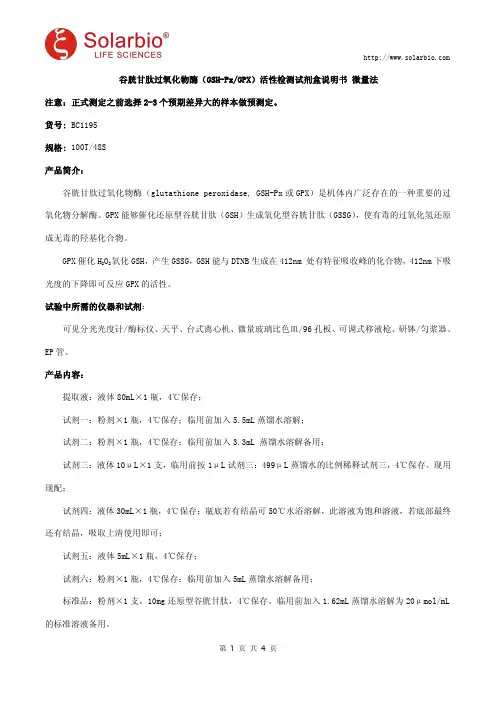
谷胱甘肽过氧化物酶(GSH-Px/GPX)活性检测试剂盒说明书微量法注意:正式测定之前选择2-3个预期差异大的样本做预测定。
货号:BC1195规格:100T/48S 产品简介:谷胱甘肽过氧化物酶(glutathione peroxidase,GSH-Px 或GPX)是机体内广泛存在的一种重要的过氧化物分解酶。
GPX 能够催化还原型谷胱甘肽(GSH)生成氧化型谷胱甘肽(GSSG),使有毒的过氧化氢还原成无毒的羟基化合物。
GPX 催化H 2O 2氧化GSH,产生GSSG,GSH 能与DTNB 生成在412nm 处有特征吸收峰的化合物,412nm 下吸光度的下降即可反应GPX 的活性。
试验中所需的仪器和试剂:可见分光光度计/酶标仪、天平、台式离心机、微量玻璃比色皿/96孔板、可调式移液枪、研钵/匀浆器、EP 管。
产品内容:提取液:液体80mL×1瓶,4℃保存;试剂一:粉剂×1瓶,4℃保存;临用前加入5.5mL 蒸馏水溶解;试剂二:粉剂×1瓶,4℃保存;临用前加入3.3mL 蒸馏水溶解备用;试剂三:液体10μL×1支,临用前按1μL 试剂三:499μL 蒸馏水的比例稀释试剂三,4℃保存。
现用现配;试剂四:液体30mL×1瓶,4℃保存;瓶底若有结晶可50℃水浴溶解,此溶液为饱和溶液,若底部最终还有结晶,吸取上清使用即可;试剂五:液体5mL×1瓶,4℃保存;试剂六:粉剂×1瓶,4℃保存;临用前加入5mL 蒸馏水溶解备用;标准品:粉剂×1支,10mg 还原型谷胱甘肽,4℃保存。
临用前加入1.62mL 蒸馏水溶解为20μmol/mL 的标准溶液备用。
操作步骤:一、粗酶液的提取:1、组织:按照组织质量(g):提取液体积(mL)为1:5~10的比例(建议称取0.05g组织,加入1mL提取液)进行冰浴匀浆。
10000rpm,4℃离心10min,取上清置冰上待测(如上清不清澈,再离心3min)。
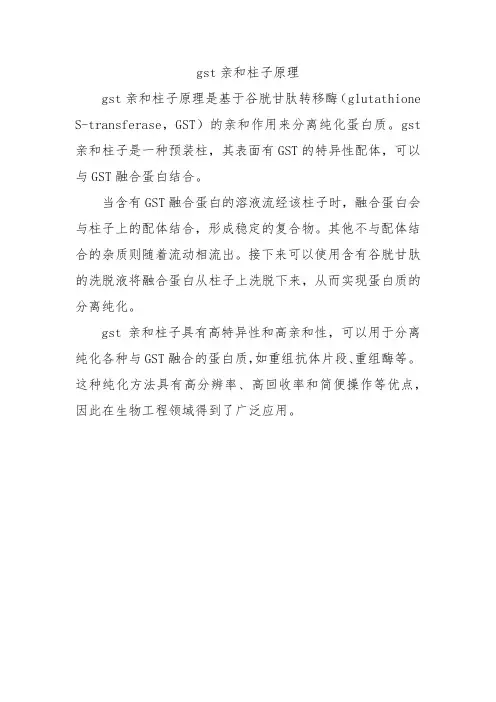
gst亲和柱子原理
gst亲和柱子原理是基于谷胱甘肽转移酶(glutathione S-transferase,GST)的亲和作用来分离纯化蛋白质。
gst 亲和柱子是一种预装柱,其表面有GST的特异性配体,可以与GST融合蛋白结合。
当含有GST融合蛋白的溶液流经该柱子时,融合蛋白会与柱子上的配体结合,形成稳定的复合物。
其他不与配体结合的杂质则随着流动相流出。
接下来可以使用含有谷胱甘肽的洗脱液将融合蛋白从柱子上洗脱下来,从而实现蛋白质的分离纯化。
gst亲和柱子具有高特异性和高亲和性,可以用于分离纯化各种与GST融合的蛋白质,如重组抗体片段、重组酶等。
这种纯化方法具有高分辨率、高回收率和简便操作等优点,因此在生物工程领域得到了广泛应用。
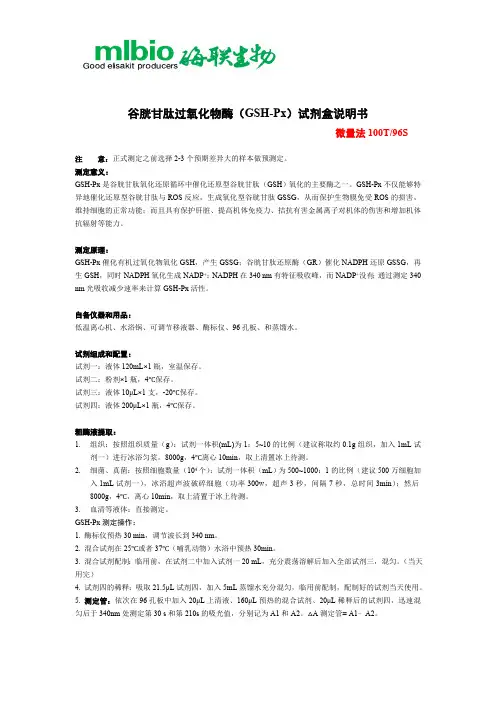
谷胱甘肽过氧化物酶(GSH-Px)试剂盒说明书微量法100T/96S注意:正式测定之前选择2-3个预期差异大的样本做预测定。
测定意义:GSH-Px是谷胱甘肽氧化还原循环中催化还原型谷胱甘肽(GSH)氧化的主要酶之一。
GSH-Px不仅能够特异地催化还原型谷胱甘肽与ROS反应,生成氧化型谷胱甘肽GSSG,从而保护生物膜免受ROS的损害,维持细胞的正常功能;而且具有保护肝脏、提高机体免疫力、拮抗有害金属离子对机体的伤害和增加机体抗辐射等能力。
测定原理:GSH-Px催化有机过氧化物氧化GSH,产生GSSG;谷胱甘肽还原酶(GR)催化NADPH还原GSSG,再生GSH,同时NADPH氧化生成NADP+;NADPH在340 nm有特征吸收峰,而NADP+没有;通过测定340 nm光吸收减少速率来计算GSH-Px活性。
自备仪器和用品:低温离心机、水浴锅、可调节移液器、酶标仪、96孔板、和蒸馏水。
试剂组成和配置:试剂一:液体120mL×1瓶,室温保存。
试剂二:粉剂×1瓶,4℃保存。
试剂三:液体10μL×1支,-20℃保存。
试剂四:液体200μL×1瓶,4℃保存。
粗酶液提取:1. 组织:按照组织质量(g):试剂一体积(mL)为1:5~10的比例(建议称取约0.1g组织,加入1mL试剂一)进行冰浴匀浆。
8000g,4℃离心10min,取上清置冰上待测。
2. 细菌、真菌:按照细胞数量(104个):试剂一体积(mL)为500~1000:1的比例(建议500万细胞加入1mL试剂一),冰浴超声波破碎细胞(功率300w,超声3秒,间隔7秒,总时间3min);然后8000g,4℃,离心10min,取上清置于冰上待测。
3. 血清等液体:直接测定。
GSH-Px测定操作:1. 酶标仪预热30 min,调节波长到340 nm。
2. 混合试剂在25℃或者37℃(哺乳动物)水浴中预热30min。
3. 混合试剂配制:临用前,在试剂二中加入试剂一20 mL,充分震荡溶解后加入全部试剂三,混匀。
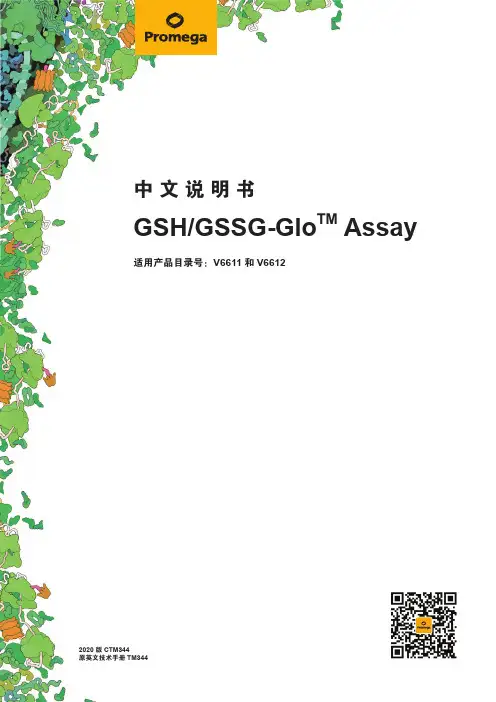
中 文 说 明 书适用产品目录号:V6611和V66122020 版 CTM344原英文技术手册TM344GSH/GSSG-Glo TMAssay普洛麦格(北京)生物技术有限公司Promega (Beijing) Biotech Co., Ltd 地址:北京市东城区北三环东路36号环球贸易中心B座907-909电话:************网址:技术支持电话:800 810 8133(座机拨打),400 810 8133(手机拨打)技术支持邮箱:*************************TM3442020制作1GSH/GSSG-Glo™ Assay所有技术文献的英文原版均可在/ protocols 获得。
请访问该网址以确定您使用的说明书是否为最新版本。
如果您在使用该试剂盒时有任何问题,请与Promega 北京技术服务部联系。
电子邮箱:*************************1. 产品描述 (2)2. 产品组分和储存条件 (3)3. 进行GSH/GSSG-Glo™ Assay (5)3.A 一般注意事项 (5)3.B. 试剂制备 (6)3.C. 推荐对照 (10)3.D. 哺乳动物贴壁细胞中GSSG和总谷胱甘肽的检测步骤 (11)3.E. 悬浮液培养细胞中GSSG和总谷胱甘肽的检测步骤 (12)4. 数据分析 (13)5. 附录 (15)5.A.缓冲液和溶液的成分 (15)5.B.培养板布局 (15)5.C.参考文献 (16)5.D.样品数据 (17)5.E.疑难解答 (18)5.F.相关产品 (19)6. 内容变更总结 (21)普洛麦格(北京)生物技术有限公司Promega (Beijing) Biotech Co., Ltd 地址:北京市东城区北三环东路36号环球贸易中心B座907-909电话:************网址:技术支持电话:800 810 8133(座机拨打),400 810 8133(手机拨打)技术支持邮箱:*************************TM3442020制作21. 产品描述作为一种含有三种氨基酸的肽(γ-谷氨酰-半胱氨酰甘氨酸),谷胱甘肽是一种广泛存在于真核细胞中的抗氧化剂(1-3)。
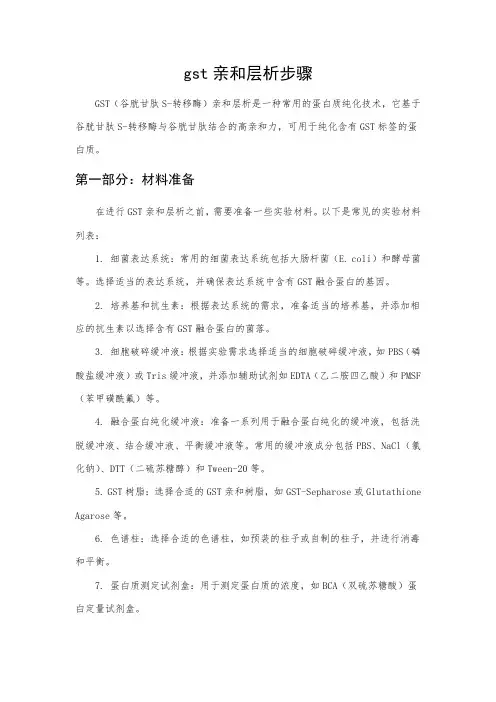
gst亲和层析步骤GST(谷胱甘肽S-转移酶)亲和层析是一种常用的蛋白质纯化技术,它基于谷胱甘肽S-转移酶与谷胱甘肽结合的高亲和力,可用于纯化含有GST标签的蛋白质。
第一部分:材料准备在进行GST亲和层析之前,需要准备一些实验材料。
以下是常见的实验材料列表:1. 细菌表达系统:常用的细菌表达系统包括大肠杆菌(E. coli)和酵母菌等。
选择适当的表达系统,并确保表达系统中含有GST融合蛋白的基因。
2. 培养基和抗生素:根据表达系统的需求,准备适当的培养基,并添加相应的抗生素以选择含有GST融合蛋白的菌落。
3. 细胞破碎缓冲液:根据实验需求选择适当的细胞破碎缓冲液,如PBS(磷酸盐缓冲液)或Tris缓冲液,并添加辅助试剂如EDTA(乙二胺四乙酸)和PMSF (苯甲磺酰氟)等。
4. 融合蛋白纯化缓冲液:准备一系列用于融合蛋白纯化的缓冲液,包括洗脱缓冲液、结合缓冲液、平衡缓冲液等。
常用的缓冲液成分包括PBS、NaCl(氯化钠)、DTT(二硫苏糖醇)和Tween-20等。
5. GST树脂:选择合适的GST亲和树脂,如GST-Sepharose或Glutathione Agarose等。
6. 色谱柱:选择合适的色谱柱,如预装的柱子或自制的柱子,并进行消毒和平衡。
7. 蛋白质测定试剂盒:用于测定蛋白质的浓度,如BCA(双硫苏糖酸)蛋白定量试剂盒。
第二部分:GST融合蛋白的表达和纯化1. 转化细菌:将含有GST融合蛋白基因的质粒DNA转化到表达宿主细胞中,如E. coli。
通过热激冷冻法、电穿孔法或化学法等方法将质粒DNA导入细菌细胞内。
2. 培养细菌:将转化后的细菌菌落接种到含有适当抗生素的培养基中,并在适当的条件下培养细菌,如温度、pH值和搅拌速度等。
3. 蛋白表达诱导:当细菌培养达到适当的生长阶段时,添加适当浓度的诱导剂,如IPTG(异丙基硫代-β-D-半乳糖苷),以诱导GST融合蛋白的表达。
4. 细胞收获:在蛋白表达诱导后一定时间,收集细菌细胞。
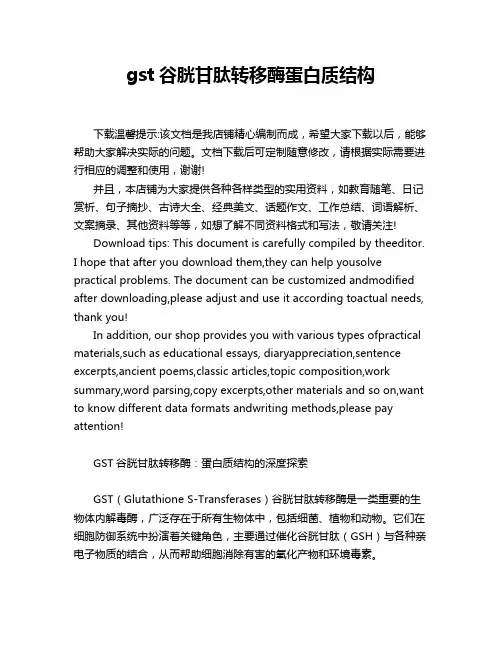
gst谷胱甘肽转移酶蛋白质结构下载温馨提示:该文档是我店铺精心编制而成,希望大家下载以后,能够帮助大家解决实际的问题。
文档下载后可定制随意修改,请根据实际需要进行相应的调整和使用,谢谢!并且,本店铺为大家提供各种各样类型的实用资料,如教育随笔、日记赏析、句子摘抄、古诗大全、经典美文、话题作文、工作总结、词语解析、文案摘录、其他资料等等,如想了解不同资料格式和写法,敬请关注!Download tips: This document is carefully compiled by theeditor.I hope that after you download them,they can help yousolve practical problems. The document can be customized andmodified after downloading,please adjust and use it according toactual needs, thank you!In addition, our shop provides you with various types ofpractical materials,such as educational essays, diaryappreciation,sentence excerpts,ancient poems,classic articles,topic composition,work summary,word parsing,copy excerpts,other materials and so on,want to know different data formats andwriting methods,please pay attention!GST谷胱甘肽转移酶:蛋白质结构的深度探索GST(Glutathione S-Transferases)谷胱甘肽转移酶是一类重要的生物体内解毒酶,广泛存在于所有生物体中,包括细菌、植物和动物。
谷胱甘肽转移酶在植物抵抗非生物胁迫方面的角色谷胱甘肽转移酶(glutathione S-transferase,GST)是一类广泛存在于植物、动物和微生物中的酶,其具有催化谷胱甘肽(glutathione,GSH)与各种亲电性物质结合的能力。
因此,GST可参与植物的许多生理和代谢过程,例如调节氧化还原状态、解毒代谢产物、维持免疫稳态等。
在植物抵御非生物胁迫方面,GST显现出重要的作用。
一方面,GST参与了植物对多种化学物质的解毒作用。
许多农药、重金属等环境污染物对植物的生长和发育具有严重的危害,而GST可以通过将这些有害物质与谷胱甘肽还原成无毒物质进行解毒。
例如,在植物受到除草剂禾草灵(2,4-dichlorophenoxyacetic acid,2,4-D)的胁迫时,GST的活性会显著增强,进而降低禾草灵的毒性,保护植物免受其伤害。
另一方面,GST也介导了植物的抗氧化应答。
氧化胁迫是影响植物生长和发育的一个重要因素,它会导致许多有害氧自由基的释放和累积,对细胞膜、蛋白质和核酸等生物大分子造成损伤。
然而,GST可以与氧自由基结合,形成稳定的产物,并且能通过调节各种氧化还原酶的活性,减轻氧化胁迫带来的不良影响。
例如,在盐胁迫的情况下,GST可以与过氧化氢进行结合,减轻ROS的毒性,维持细胞内氧化还原平衡。
除此之外,GST也参与了植物的信号转导和细胞壁合成等过程,总体上显现出了对植物逆境适应的重要作用。
值得注意的是,不同的植物在不同的环境中所表现出的GST特异性和功能也存在差异,这对植物抵御非生物胁迫的策略选择和调整具有一定的指导意义。
总之,谷胱甘肽转移酶在植物抵御非生物胁迫方面发挥了重要的调节作用,它可以通过解毒作用和抗氧化应答等机制,降低环境污染物和氧化自由基对植物的损伤,保护植物的生长和发育。
在今后的研究中,我们可以进一步探究GST在植物逆境生存中的作用机制和生物学意义。
Amicon® Pro AffinityConcentration Kit - GSTPurification of GST-tagged recombinant proteins.Catalog Nos. ACR5000GS, ACK5003GS, ACK5010GS, ACK5030GS,ACK5050GS, ACK5100GSFOR RESEARCH USE ONLYNot for use in diagnostic procedures.USA & Canada Phone: +1(800) 437-7500 Fax: +1 (951) 676-9209Australia +61 3 9839 2000IntroductionThe expression and purification of recombinant proteins is central to protein regulation, structure and function studies. Purification has been greatly facilitated by the addition of small affinity tags to protein sequences such as the glutathione S-transferase domain (GST). GST agarose resin is an affinity chromatography matrix, when used in concert with the Amicon®Pro Affinity Concentration device, offers rapid purification of GST fusion proteins, native GST, or glutathione-binding proteins. GST-tagged proteins bind specifically to reduced glutathione in near-neutral, non-denaturing conditions (e.g., phosphate buffer). Following resin capture of the target protein, unbound lysate components are removed by spin-based clearing and washing steps. Bound protein is recovered by centrifugation following competitive displacement with buffer containing free, reduced glutathione.By condensing the entire purification workflow into one device, the Amicon® Pro device eliminates the need for multiple sample transfers thereby minimizing protein loss. The large exchange device reservoir (up to 9ml) accommodates a range of sample capacities as well as reduces the need for multiple spin steps during the wash and elution phases. Direct coupling to an Amicon® Ultra-0.5 device further provides simultaneous concentration during the elution phase. Lastly, the Amicon® Pro device offers highly efficient diafiltration in a single 15 minute spin.The kit contains sufficient GST resin, optimized buffers, and Amicon® Pro devices for 12 standard reactions.Sample Preparation GuidelinesOptimizing lysis parameters is critical for protein extraction and downstream purification. The Amicon®Pro Affinity Concentration GST kit is compatible with a range of conditions, including reducing agents (β-mercaptoethanol, DTT), chelating agents (EDTA), non-ionic detergents, and BugBuster®Protein Extraction Reagent (Cat. No. 70584), a proprietary mixture of non-ionic detergents offering a rapid cost-effective alternative to mechanical cell lysis methods such as sonication.Irrespective of extraction method, we recommend inclusion of rLysozyme™ Solution (Cat. No.71110) and Benzonase®Nuclease (Cat. No. 70746) and during protein extraction for increased cell lysis (protein yield) and a reduction in sample viscosity (improved sample handling), respectively.Protease inhibitors may also be added to the lysis buffers to protect against degradative enzymes.A listing of individual protease inhibitors and cocktails is available at /search on key words “Protease Inhibitor.” Note: Serine proteases should be used with caution if the GST fusion tag is to be cleaved via Thrombin or Factor Xa digestion. If used during protein extraction, we strongly recommend the eluted fraction be buffer exchanged prior to performing the cleavage reaction.In certain systems, high protein expression can lead to aggregation in the form of inclusion bodies.Strong denaturants such as 6 M guanidine or 8 M urea can be used to solubilize aggregates greatly enhancing yield. However, only properly folded, functional GST is capable of binding GST resin. GST fractions recovered from denaturation of inclusion bodies must be refolded to reconstitute active GST fusion constructs. To a degree, this can be accomplished through use of the Protein Refolding Kit (Cat. No. 70123).Cat. No. BWEGSFor more information, consult the GST•Bind™ Resin User Guide available at /chemicals. Search using the Cat. No. 70541.Kit ComponentsCS211421-GST Resin (3 mL) – Crosslinked agarose with immobilized reduced glutathione supplied as 50% slurry in 50 mM Phosphate Buffer pH 7.5, 0.15 M NaCl, 0.1% NaN3. The resin utilizes an 11-atom spacer arm (~16 Å) for covalent attachment of reduced glutathione via a sulfide linkage. The binding capacity is typically 5-8 mg/mL of settled resin.Buffers:o CS211416-10X GST Bind/Wash Buffer (25 mL) – 43 mM Na2HPO4, 14.7 mM KH2PO4,1.37 M NaCl, 27 mM KCl pH7.2o CS211354-10X Glutathione Reconstitution buffer (5 mL) – 500 mM Tris, pH 8.0o CS211418-Glutathione, reduced, free acid (125 mg)Amicon®Pro Devices – The kit includes 12 complete assemblies. Each device consists of an exchange device, holder tube, 50 mL collection tube, and Amicon®Ultra-0.5 centrifugal filter device. A 2 mL collection tube is included for sample recovery from the AU-0.5 device by reverse spin. The kit is available in five formats based on the nominal molecular weight limit (NMWL) of the AU-0.5: 3 (ACK5003GS), 10 (ACK5010GS), 30 (ACK5030GS), 50 (ACK5050GS), and 100 kDa (ACK5100GS). Consult the Amicon®Pro (/psp, search keywords “Amicon Pro”) and Amicon®Ultra-0.5 centrifugal filter device User Guides (/catalogue/module/c82301) for proper assembly/disassembly and additional product information.All reagents should be stored at 2° to 8°C (do not freeze). The Amicon Pro devices can be stored separately at room temperature.Procedures for using the Amicon® Pro Affinity Concentration Kit - GSTThe protocol is based on purification of GST-tagged protein from 1 mL of E. coli lysate using 200 µl of GST resin slurry (100 µL packed resin). The protocol is linearly scalable for 50-1000 µL of resin slurry. Due to large variability among sample preps, parameters which may require optimization include bead input, binding time, wash, and elution parameters. This protocol includes steps for simultaneous concentration during the elution step as well as buffer exchange using the Amicon®Ultra-0.5 centrifugal filter device.Note: Given the collection tube’s capacity, it is not necessary to remove filtrate between the various centrifugation steps. However, if process samples need be retained for analytical purposes, the collection tube should be cleared.Buffer Preparation10X Bind/Wash Buffer should be diluted to 1X with sterile deionized H2O; 1X Bind/Wash solution may be stored at 4°C for 1 week.Prepare 10X GST Elution Buffer containing 100 mM reduced glutathione as follows: add 4ml 10X Reconstitution buffer directly to the glutathione powder vial. Pipette repeatedly then incubate for30 minutes at room temperature. Divide buffer into working volumes and store at -20o C (400Cat. No. BWEGSµl/standard reaction); 10X GST Elution Buffer is stable for 6 months at -20o C. We do not recommend repeated freeze/thaw cycles. To minimize glutathione oxidation, dilute 10X buffer to 1X using sterile deionized water and pH to 8.0 immediately before use. Discard any unused 1X Elution Buffer.Bead Preparation1. To ensure uniform suspension, vortex the GST resin thoroughly before adding it to the device.2. Remove the collection tube cap and open the exchange device cap.3. Add 200 µL of resin slurry to the base of the exchange device. Close the exchange cap.Up to 500 µl packed resin (1000 µl slurry volume) may be added per device We recommend using wide-bore tips (Cat. No. 02-707-134, Fisher Scientific) for resin transfer.4. To remove storage buffer, centrifuge in a swinging bucket rotor at 1000 g X 1 min.5. Add 500 µL of 1X Bind Buffer. Centrifuge at 1000 g X 1 min.Protein Binding1. Add 500 µL of sample to the exchange device.Up to 9 mL of sample can be added. The volume loaded is determined by the target protein’s expression level and resin’s binding capacity.2. Incubate for 60 min at room temp with gentle agitation.We recommend upright agitation on a plate shaker at low setting.End-over-end mixing, particularly with small volumes or for extended time, may result in substantial bead loss to the sides of the feeder tube.The duration of binding time may vary with application.3. Centrifuge the device at 1000 g X 1 min in a swinging bucket rotor. Recover the sample flow-through from the 50 mL collection tube (optional).To ensure maximal protein capture, collect all resin into solution prior to centrifugation.4. Add1.5 mL of Wash Buffer. Centrifuge at 1000 g X 1 min. Recover the wash fraction from the 50mL collection tube (optional).Due to the large capacity of the exchange device, the volume of the wash can be increased for greater sample purity. There is no need for multiple wash steps.Sample ElutionSamples can be eluted without concentration by adding elution buffer and centrifuging (1000g X 2 minute) directly into a clean 50 ml collection tube. Given the limited volume processing capacity of the AU-0.5 device, we recommend this protocol if elution volumes > 1.5 ml are required.For simultaneous elution with concentration, attach the Amicon® Ultra-0.5 device and follow the steps outlined below.1. Remove the exchange device and insert it into the AU0.5 device.2. Place the exchange device/AU-0.5 assembly back in the holder and return the device to thecollection tube.3. Add up to 1.5 mL of Elution Buffer, gently resuspend the resin, and incubate for 5 min.Under standard conditions, one elution is sufficient for recovery of 90-95% of captured protein.4. Close the exchange device cap and screw on the collection tube cap to ensure a proper seal.5. Centrifuge at 4000 g X 15 min in a swinging bucket rotor. Concentrated samples can be bufferexchanged or recovered from the AU-0.5 device by reverse spin (see below).Cat. No. BWEGSDepending on the starting elution volume, NMWL of AU0.5 device employed, and the degree of concentration desired, the length of the spin time can range for 10-30 minutes. Please consult the Performance Characteristics section in the Amicon®Pro Affinity Concentration System User Guide (/psp, and search keywords "Amicon Pro”) for recommended guidelines., consult.6. Recover the concentrated fraction by reverse spin or proceed to Buffer Exchange (see below).Buffer Exchange (Optional if samples have been collected in the Amicon® Ultra-0.5 device)1. After sample concentration, add 1.5ml desired buffer to the exchange device/AU-0.5 assembly.2. Centrifuge device at 4000g X 15 minutes in a swinging bucket rotor. Concentrated samples canbe recovered from the AU-0.5 device by reverse spin (see below).Collect sample from the AU0.5 device by Reverse Spin(following Concentration or Buffer Exchange)1. Disassemble the exchange device/AU-0.5 assembly from the holder tube.2. Using a gentle twisting motion, detach the AU-0.5 from the exchange device.3. If there is residual sample in the exchange device tip, depress the exchange device cap to expelthe remaining sample volume into the AU-0.5.4. Hold AU-0.5 upright and slide the 2 ml collection tube on top of it.5. Invert the assembly and centrifuge (in a microcentrifuge) with a fixed angle rotor 1000g X 2min.Sample protein yield can be determined by Mid IR-based spectrometry using the DirectDetect™ biomolecular quantitation system and DirectDetect™ Assay Free Sample Cards.TroubleshootingCat. No. BWEGSIssue: Recombinant Protein is present in low amount in eluatePossible Cause SolutionProtein is insoluble and may have formed inclusion bodies. After lysate clearance, check both the supernatant and pellet for protein. Perform lysis and binding procedures under denaturing conditions.The GST fusion protein is not in the proper three dimensional conformation. Attempt to reconstitute native protein structure using Protein Refolding Kit (Cat. No. 70532).The GST-tag is not exposed for binding to the affinityresin.The protein may require denaturing conditions for binding.The GST-tag is not present. Sequence the ligation junctions to ensure that the readingframe is correct. Check for possible internal translation starts(N-terminal tag) or premature termination sites (C-terminal tag). Recombinant protein is degraded during cell lysis. Add protease inhibitors during cell lysis.Protein forms aggregates. Add solubilizing agents such as detergents (0.1% Triton® X-100, TWEEN®-20) or increase salt concentration.pH of the Lysis or Binding buffers is incorrect. Check buffer pH; the acceptable range is 7-8. Acidic bufferswill prevent binding.Protein expression is insufficient. Optimize the growth/induction conditions.Cell Lysis is incomplete. Optimize the Cell Lysis Protocol.Cell Lysate is too viscous. If possible, dilute the lysate in Bind Buffer. Alternatively,include Benzonase® Nuclease during lysis to remove freeRNA/DNA.Protein precipitates during sample concentration while using the AU0.5 device due to over-concentration. Reduce the duration of the centrifugation time during the elution/concentration step.Protein is lost during sample concentration while using AU0.5 device. Check the protein's expected size and MWCO of AU0.5 device used. AU0.5 device is offered in 5 different MWCO formats - 3, 10, 30, 50, and 100 kDa.Issue: High Non-specific bindingPossible Cause SolutionInsufficient washing. Increase the volume of the Wash Buffer used or the number ofwash steps. Alternatively, supplement the Bind/Wash Buffers.Contaminants interact directly with the GST fusion protein. Add reducing agents such as DTT or β-mercaptoethanol to reduce disulfide bonds. Add detergents to disrupt non-specific interactions.GST fusion protein is degraded. Degraded/truncated forms of the recombinant protein will stillbind to the GST resin and appear as contaminating bands inSDS-PAGE. Perform a lysis procedure on ice and includeprotease inhibitors.Cell lysate is too concentrated. Dilute the lysate in Bind Buffer before purification.Cat. No. BWEGSCat. No. BWEGSPerformanceProduct Ordering InformationNo Devices Amicon ® Pro + AU 0.5 ml with MWCO: 3k 10k 30k 50k 100k Amicon ® Pro Affinity Concentration Kit - GSTACR5000GS ACK5003GS ACK5010GS ACK5030GS ACK5050GS ACK5100GS Amicon ® Pro AffinityConcentration System 12PKACS500312 ACS501012 ACS503012 ACS505012 ACS510012 Amicon ® Pro AffinityConcentration System 24PK ACS500324 ACS501024 ACS503024 ACS505024 ACS510024The Amicon ® Pro Affinity Concentration Kit contains reagents and devices sufficient for 12 standard reactions. Amicon ® Pro devices are also sold separately in 12 and 24 packs.Description Catalogue Number Qty/Pack GST•Bind™ Resin 70541-3/4/5 10/50/25 mL GST•Bind™ Buffer Kit 70534 1 KitPurification using Amicon Pro Affinity Concentration Kit – GST purifications of a 50 kDa GST-tagged protein the Amicon ® Pro Affinity Concentration Kit numbered lanes are: 2 – flowthrough fraction 3 – wash fraction 4 – eluted fractionNoticeThe information in this document is subject to change without notice and should not be construed as a commitment by EMD Millipore Corporation (“Millipore”) or an affiliate. Neither EMD Millipore nor any of its affiliates assumes responsibility for any errors that may appear in this document. Technical AssistanceFor more information, contact the office nearest you. Up-to-date world-wide contact information is available on our web site at /offices. You can also visit the tech service page on our web site at /techserves.WarrantyEMD Millipore Corporation(“EMD Millipore”) warrants its products will meet their applicable published specifications when used in accordance with their applicable instructions for a period of one year from shipment of the products. EMD MILLIPORE MAKES NO OTHER WARRANTY, EXPRESSED OR IMPLIED. THERE IS NO WARRANTY OF MERCHANTABILITY OR FITNESS FOR A PARTICULAR PURPOSE. The warranty provided herein and the data, specifications and descriptions of EMD Millipore products appearing in EMD Millipore’s published catalogues and product literature may not be altered except by express written agreement signed by an officer of EMD Millipore. Representations, oral or written, which are inconsistent with this warranty or such publications are not authorized and if given, should not be relied upon.In the event of a breach of the foregoing warranty, EMD Millipore Corporation’s sole obligation shall be to repair or replace, at its option, the applicable product or part thereof, provided the customer notifies EMD Millipore Corporation promptly of any such breach. If after exercising reasonable efforts, EMD Millipore Corporation is unable to repair or replace the product or part, then EDM Millipore shall refund to the Company all monies paid for such applicable Product. EMD MILLIPORE CORPORATION SHALL NOT BE LIABLE FOR CONSEQUENTIAL, INCIDENTAL, SPECIAL OR ANY OTHER DAMAGES RESULTING FROM ECONOMIC LOSS OR PROPERTY DAMAGE SUSTAINED BY ANY COMPANY CUSTOMER FROM THE USE OF ITS PRODUCTS.Unless otherwise stated in our catalog or other company documentation accompanying the product(s), our products are intended for research use only and are not to be used for any other purpose, which includes but is not limited to, unauthorized commercial uses, in vitro diagnostic uses, ex vivo or in vivo therapeutic uses or any type of consumption or application to humans or animals.(c) 2009 - 2012: Merck KGaA, Darmstadt. All rights reserved. No part of these works may be reproduced in any form without permission in writing.Benzonase®, BugBuster®, and Amicon® are registered trademarks of Merck KGaA, Darmstadt, Germany. DirectDetect™ and GST•Bind™ is a trademark of Merck KGaA, Darmstadt, Germany. Triton® is a registered trademark of Dow Chemical Company. Tween® is a registered trademark of ICI Americas, Inc.Cat. No. BWEGS。
核准日期:修改日期:谷胱甘肽含片说明书请仔细阅读说明书并在医师的指导下使用【药品名称】通用名称:谷胱甘肽含片商品名称:英文名称:Glutathione Buccal Tablets汉语拼音:Guguanggantai Hanpian【成份】本品主要成份为谷胱甘肽化学名称: -L-谷氨酰-L-半胱氨酰-甘氨酸化学结构式:分子式C10H17N3O6S分子量:307.33【性状】本品为白色或类白色片【适应症】本品用于慢性肝脏疾病的辅助治疗。
包括病毒性、药物毒性、酒精毒性引起的肝脏损害。
【规格】0.1g【用法用量】置于颊粘膜与齿龈间含服。
成人一日3次,每次0.3g(3片),一般30天为一疗程。
【不良反应】1.轻度口腔粘膜白斑、溃疡、舌苔剥脱和疼痛等口腔不适。
2.罕见突发性皮疹。
3.偶有食欲不振,恶心,呕吐,上腹痛等症。
【禁忌】对本品成分过敏者禁用。
【注意事项】1.当发生口腔不良反应时,建议停用本品。
2.放在儿童不易触及的地方。
3.苯丙酮尿患者慎用。
【孕妇及哺乳期妇女用药】缺少相关资料【儿童用药】尚不明确【老年用药】尚不明确【药物相互作用】本品和下列药物应避免混合使用:维生素K3、维生素B12、泛酸钙、乳清酸、抗组织胺药、长效磺胺药和四环素。
【药物过量】尚未见到有关本品药物过量的资料。
如发生药物过量应对症治疗。
【药理毒理】谷胱甘肽是含有巯基(SH)的三肽化合物,在人体内具有活化氧化还原系统,激活SH酶、解毒作用等重要生理活性。
谷胱甘肽在体内以还原型和氧化型两种形式存在,其活性成份为还原型谷胱甘肽。
还原型谷胱甘肽参与体内三羧酸循环及糖代谢,促进体内产生高能量,起到辅酶作用。
还原型谷胱甘肽是甘油醛磷酸脱氢酶的辅基,又是乙二醛酶及磷酸丙糖脱氢酶的辅酶。
还原型谷胱甘肽能激活体内的SH酶等,促进碳水化合物、脂肪及蛋白质的代谢,以调节细胞膜的代谢过程。
还原型谷胱甘肽参与多种外源性、内源性有毒物质结合生成减毒物质。
【药代动力学】小鼠静注还原型谷胱甘肽后,约5小时后血药浓度达峰值,清除半衰期约 24小时,在肝、肾、肌肉分布最多。
Uscn Life Science Inc.Wuhan网址:电话:+862784259552传真:+862784259551E-mail:***************大鼠谷胱甘肽(GSH)酶联免疫吸附测定试剂盒使用酶联免疫吸附测定试剂盒使用说明书说明书产品编号:E0294Ra规格:96T本试剂盒仅供体外研究使用,不用于临床诊断!预期应用本酶联免疫吸附测定试剂盒运用竞争抑制酶标免疫分析法定量测定大鼠血清、血浆、组织匀浆或其它相关生物液体中GSH 含量。
本试剂盒试剂盒未提供但需自备的设备及试剂未提供但需自备的设备及试剂1、450±10nm 滤光片的酶标仪(建议仪器使用前提前预热)2、单道和多道微量加液器及吸头3、稀释样品的EP 管4、蒸馏水或去离子水5、吸水纸6、盛放洗液的容器试剂盒的储存及有效期所有试剂均按试剂瓶标签上所示保存。
请注意,收到试剂盒后请尽快将标准品、检测溶液A 以及96孔板保存于-20。
开封后的酶标板要密封加干燥剂后保存于-20,避免潮湿。
有效期为6个月。
实验原理本试剂盒应用竞争抑制酶标免疫分析法测定标本中待测物质水平。
用纯化的抗体包被微孔板,制成固相抗体,往包被抗体的微孔中同时加入酶标的抗原和待测抗原,被测抗原与酶标记抗原对特异性抗体进行竞争结合。
经过彻底洗涤后用底物TMB 显色。
TMB 在过氧化物酶的催化下转化成蓝色,并在酸的作用下转化成最终的黄色。
待测标本浓度越高,标记抗原和抗体的结合就越受到抑制,显色愈浅。
显色的深浅与酶量呈正相关,而与样品中待测物质含量呈负相关。
用酶标仪在450nm波长下测定吸光度(值),计算样品浓度。
标本的采集标本的采集与与保存1、血清:将收集于血清分离管的全血标本在室温放置30分钟或4过夜,然后1000g离心20分钟,取上清即可检测,或将上清置于-20或-80保存,但应避免反复冻融。
2、血浆:用EDTA或肝素作为抗凝剂采集标本,并将标本在采集后的30分钟内于2-81000g离心15分钟,取上清即可检测,或将上清置于-20或-80保存,但应避免反复冻融。
还原型谷胱甘肽(reduced glutathione,GSH)含量测定试剂盒使用说明产品简介:GSH/GSSG是细胞内最重要的氧化还原对之一。
因此,测定细胞内GSH和GSSG含量以及GSH/GSSG比值,能够很好地反映细胞所处的氧化还原状态。
DTNB与GSH反应生成复合物,在412nm处有特征吸收峰;其吸光度变化与GSH含量成正比。
试验中所需的仪器和试剂:可见分光光度计、低温离心机、水浴锅、可调节移液器、1ml比色皿、双蒸水产品内容:试剂一×1支,充分溶解于100ml双蒸水,4℃保存试剂二×1支,充分溶解于50ml试剂一中,4℃保存试剂三×1支,充分溶解于10ml双蒸水中,4℃避光保存操作步骤:一、样品前处理:取组织约0.1g,加1ml试剂二,冰上充分研磨,8000rpm4℃离心10min,取上清。
(如上清不清澈,再离心3min)GSH测定操作:测定前将试剂一于25℃水浴20min按每100mg组织加入1000µL生理盐水的比例进行匀浆。
8000g4℃离心10分钟,取上清,置冰上待测。
对于非哺乳动物组织:按每100mg组织加入1000µL提取液的比例进行匀浆。
8000g 4℃离心10分钟,取上清,置冰上待测。
(2)血清(浆)样品:直接检测。
二、测定操作表:测定管空白管样本0.1ml/试剂一0.7ml0.7ml蒸馏水/0.1ml试剂三0.2ml0.2ml 迅速混匀,于412nm测吸光值,并记录第60s的OD值GSH含量计算:GSH标准曲线公式:y=0.0015x+0.0818(x为GSH浓度,y为吸光值)液体中GSH(µmol/L)=[(OD测定管-OD空白管)-0.0818]/0.0015×样品稀释倍数组织中GSH计算:①GSH(µmol/mg prot)=[(OD测定管-OD空白管)-0.0818]/0.0015×样品稀释倍数÷样品蛋白浓度(Cpr)②GSH(µmol/g mass)=[(OD测定管-OD空白管)-0.0818]/0.0015×样品稀释倍数÷样品质量(g)注意事项:(1)样品处理等过程均需要在冰上进行,且须在当日测定酶活力,以免影响其活力测定时,除试剂一外,其它试剂均需放置在冰上;(2)样本测定前先取1-2个样做预实验,如吸光值太高(超过标准曲线范围,即y >0.2时),应先用试剂二稀释到适当倍数,使得吸光值在标准曲线范围内。
第1页,共2页
货号:QS1204 规格:50管/48样
谷胱甘肽S-转移酶(glutathione S-transferase,GST)试剂盒说明书
紫外分光光度法
注意:正式测定之前选择 2-3 个预期差异大的样本做预测定。
测定意义:
GST是一种具有多种生理功能的蛋白质家族,主要存在于细胞质内。GST是体内解毒酶系
统的重要组成部分,主要催化各种化学物质及其代谢产物与GSH的巯基共价结合,使亲电化合
物变为亲水物质,易于从胆汁或尿液中排泄,达到将体内各种潜在或具备毒性的物质降解并排
出体外的目的。因此,GST在保护细胞免受亲电子化合物的损伤中发挥着重要的生物学功能。
此外,因为GST具有GSH-Px活性,亦称为non-Se GSH-Px,具有修复氧化破坏的大分子如DNA、
蛋白质等的功能。注意,GST催化的反应减少GSH含量,但是不增加GSSG含量。
测定原理:
GST催化GSH与CDNB结合,其结合产物的光吸收峰波长为340nm;通过测定340nm波长处
吸光度上升速率,即可计算出GST活性。
自备实验用品及仪器:
紫外分光光度计、低温离心机、水浴锅、可调节移液器、1mL石英比色皿和蒸馏水。
试剂组成和配置:
试剂一:液体50mL×1瓶,4℃保存。
试剂二:液体45mL×1瓶,4℃保存。
试剂三:粉剂×1瓶,4℃保存。临用前加5 mL蒸馏水溶解。
粗酶液提取:
1. 组织:按照组织质量(g):试剂一体积(mL)为1:5~10的比例(建议称取约0.1g组织,加
入1mL试剂一)进行冰浴匀浆。8000g,4℃离心10min,取上清置冰上待测。
2. 细菌、真菌:按照细胞数量(104个):试剂一体积(mL)为500~1000:1的比例(建议500
万细胞加入1mL试剂一),冰浴超声波破碎细胞(功率300w,超声3秒,间隔7秒,总时
间3min);然后8000g,4℃,离心10min,取上清置于冰上待测。
3. 血清等液体:直接测定。
测定操作:
1. 分光光度计预热30 min,调节波长到340 nm,用蒸馏水调零。
2. 试剂三放在25℃(一般物种)或者37℃(哺乳动物)保温。
3. 测定管:取1mL石英比色皿,加入100μL上清液,900μL试剂二和100μL试剂三,迅速
混匀后于340nm测定吸光度变化,记录10 s和310 s吸光度为A1和A2。
GST活性计算公式:
(1). 按蛋白浓度计算
活性单位定义:在25℃或者37℃中,每毫克蛋白每分钟催化1nmol/L CDNB与GSH结合为1个
酶活单位。
GST(nmol/min/mg prot)=(A2-A1))÷ε÷d×109×V反总÷(Cpr×V样)÷T
第2页,共2页
=230×((A2-A1) ÷Cpr
(2). 按样本质量计算
活性单位定义:在25℃或者37℃中,每克样品每分钟催化1nmol/L CDNB与GSH结合为1个酶
活单位。
GST(nmol/min/g鲜重)=(A2-A1)÷ε÷d×109×V反总÷(W×V样÷V样总)÷T
=230×(A2-A1) ÷W
(3)按细胞数量计算
活性单位定义:在25℃或者37℃中,每104个细胞每分钟催化1nmol/L CDNB与GSH结合为1
个酶活单位。
GST(nmol/min/104 cell)=(A2-A1)÷ε÷d×109×V反总÷(细胞数量×V样÷V样总)÷T
=230×(A2-A1) ÷细胞数量
(4)按液体体积计算
活性单位定义:在25℃或者37℃中,每毫升液体每分钟催化1nmol/L CDNB与GSH结合为1个
酶活单位。
GST(nmol/min/mL)=(A2-A1)÷ε÷d×109×V反总÷V样÷T
= 230×(A2-A1)
ε:产物摩尔消光系数,9.6×103 L/mol /cm;d:比色皿光径,1cm;106:1mol=1×106μmol;
V反总:反应体系总体积,1100μL=0.0011 L;Cpr:上清液蛋白质浓度(mg/mL),需要另外
测定,建议选用本公司生产的BCA蛋白质浓度测定试剂盒;V样:加入反应体系中上清液体积,
100μL=0.1 mL;V样总:加入提取液体积,1mL;W,样本质量,g;T:反应时间(min),5min。
注意事项:
1. 样品处理等过程均需要在冰上进行,且须在当日测定酶活力;
2. 细胞中GST活性测定时,细胞数目须在300万-500万之间,细胞中GST的提取时可加试剂
一后研磨或超声波处理,不能用细胞裂解液处理细胞;
3. 本法测定GST活性的线性范围可达76 μmol/min /L,测定前先用1~2个样做预实验,如
5min内反应不成线性,须对样品用蒸馏水稀释,计算结果乘以稀释倍数;
4. 测定反映的温度对测定结果有影响,请控制在25℃或者37℃(哺乳动物)。